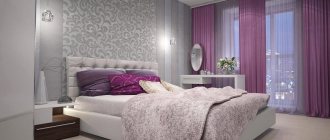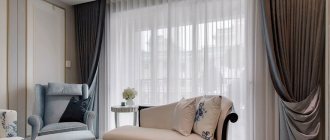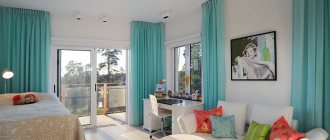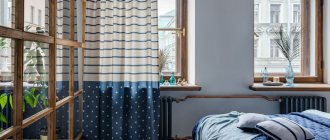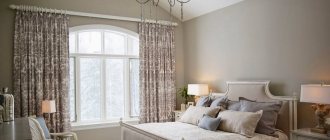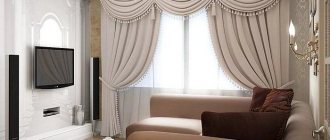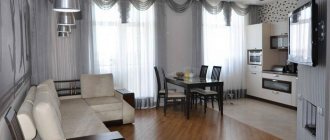Curtains can be almost invisible, or, conversely, very catchy. Sometimes curtains are more of a functional element (they protect from light and prying eyes), and sometimes they are only decorative. The color of the curtains is of great importance - it determines what effect will be achieved.
What to choose curtains for? It depends on what result we want to get. And also on what stage of interior readiness we start choosing textiles. If the interior is already furnished and decorated, curtains can be selected to match any, absolutely any component of it. If the interior is under development, we need to choose one of four schemes and, in accordance with it, carry out further work on the project.
Selecting curtain colors
To understand how to choose the color of curtains for the interior, you need to decide on several positions:
- What will the curtains be combined with (furniture, walls or decor)?
- Should they be in the same tone as the interior or, on the contrary, will they become a bright accent?
- Will they have a functional role or a decorative one?
An important factor in choosing curtains is the stage of creating the interior. If the renovation has already been completed (the walls, floors and ceilings are decorated, the decor is arranged), then the curtains are selected to match any of the interior elements. If the repair is just being designed, then the choice is guided by any of the proposed methods.
Neutral curtains
Curtains in a modern interior can be either contrasting or neutral.
Neutral colors include the following:
- white and all its shades (for example, milky, pearl, snow) - the color is especially relevant for Scandinavian interiors and various modern styles;
- beige - it fits well into rooms in contemporary, eclectic or classic styles, goes well with brown, gold and white colors;
- gray and its light and dark shades - colors suitable for rooms in a cold color palette;
- black is a very bright and active color, however, it is also rightfully considered neutral, suitable for a diverse color palette.
Curtains to match the color of the walls
The color combination of curtains and wallpaper in the interior is suitable for decorating small rooms, since the walls merge with the window into a single line, the space is not divided into parts. Also, the scheme for selecting curtains to match the color of the walls is considered the safest - there is no chance of making a mistake and choosing the wrong color. It doesn't matter what color the floor, ceiling or furniture is. If the walls and curtains are in harmony, then this is a winning option. You can play with shades and choose light brown curtains to match the brown wallpaper. By the way, they can be with a pattern, embroidery, pattern or embossing. This option will look elegant.
Curtains to match the interior color
Often bedrooms or lounges are decorated in one color, that is, the room is characterized as a “blue room” or “pink bedroom.” However, behind this formulation lies a combination of light and dark edges of the same color, its halftones and subtones.
To create the interior of a “blue room,” blue wallpaper and paint are selected, curtains and textiles are chosen in the desired blue shade, but with a pattern. This move adds liveliness to the atmosphere. Curtains fit harmoniously into the space without standing out from the general background.
Colored contrast curtains
Colored curtains in the interior are a bold accent that can completely transform a monotonous, strict design, filling it with the energy of rich colors. For neutral interiors, made in white, beige, gray or black, choose curtains in rich colors from the rainbow spectrum. For example, a white interior is enlivened by deep green curtains, and bright orange panels make it warmer.
Tip: if bright curtains seem too bold, then choose one of the neutral colors based on the principle of contrast with the rest of the color scheme of the room.
Tricolor or bicolor curtains
This scheme is suitable for both the final part of the work on the design of the room and the initial one. If the entire interior has already been decorated, then for textile decoration of the window several basic colors and patterns of the room are chosen. For example, straight-cut curtains in gray and golden colors are suitable for a modern interior.
When the interior is just being planned, the curtains are selected to match the rest of the textiles, and then the rest of the room’s color scheme is adjusted to match it. For example, beige and burgundy curtains will complement a carpet of the same color.
With carpet
In addition to furniture and pillows, there is often a carpet in the room. You can also build on it when choosing the shade of the curtains. A bright product paired with textiles will be an accent in the interior, while a monochromatic and calm product will serve as a backdrop for richer and more contrasting furnishings.
Examples of combining curtains with carpet
Shapes of modern curtains
When determining how to choose curtains for your interior, pay attention to the variety of their shapes.
Multilayer
Such products consist of several layers of fabric (usually two). One of the layers can be with a pattern, the rest are selected in plain colors. Multi-layer curtains look rich and are most often chosen for the living room or bedroom.
Lambrequins
Lambrequins have become widespread not only in the design of public buildings, but also in private interiors. Due to the different cut, lambrequins have different sizes and cut shapes. They are characterized by the use of several types of fabric, a combination of several colors, and the presence of decorative decorations in the form of eyelets, hangers, tiebacks, and fringes.
Asymmetrical
Asymmetrical curtains enliven the decor, making it original. Asymmetrical curtains are distinguished by the fact that one side is noticeably shorter than the other.
Rolled
Rolled ones are suitable for decorating a modern interior in a minimalist or high-tech style. They do not take up much space and perform a protective and decorative function at the same time.
Short
Curtains, cafe curtains and other short curtains are most often chosen for the kitchen or small rooms where they look appropriate. Regular curtains cover the upper part of the window, cafe curtains cover the lower part.
Let's sum it up
Curtains are actually one of the most important and visible elements of the interior. And if they are chosen correctly, they can significantly transform the living room for not very much money.
In this article, I tried to describe the main points that you should pay attention to and I hope that the question of how to choose curtains for the living room will now not be so difficult for you.
By the way, if, in addition to the living room, you are also interested in the question of how to choose modern curtains for the kitchen, then I recommend reading the article “Choosing curtains for the kitchen in a modern style.”
Sincerely, Tkachenko Alexander
How to choose curtain material
The variety of fabrics is very large: they are light and heavy, natural, synthetic and mixed, absorbing and reflecting light, dust-repellent and fire-resistant. Depending on special requirements, the fabric is coated with a protective layer against dust or moisture.
Among the most common types of fabric for sewing curtains, choose the following:
- organza, chiffon, voile - light translucent textiles that look airy on the window and create voluminous light folds;
- silk, satin - capricious reflective fabrics that look different in daylight and artificial light, with enough light they make the interior more elegant and richer;
- upholstery fabrics, velvet, brocade, jacquard - these are heavy fabrics, expensive in appearance and cost, suitable for decorating an office or living room;
- natural linen, satin or cotton is an environmentally friendly material that is suitable for a nursery or bedroom.
With bedspreads and pillows
In the bedroom, the easiest way to tie curtains is to the bedspread and decorative pillows. Often they are specially sewn together, intertwining colors, patterns, and decorative elements in the products. It turns out beautiful and modern.
This is what the curtains and bedspread look like in the same style in the bedroom
What types of curtains are there in style?
When designing an interior design in a certain historical or ethnic style, the designer selects furniture, decor, lamps and textiles of a certain type. These can be straight panels made of natural fabrics, lush expensive draperies or curtains with a functional opening mechanism. Among the main types of curtains, the following are most often used:
Classic
For classical and neoclassical interiors, curtains are selected from thick curtain fabric, complemented by decorations in the form of tiebacks, fringes, and hangers. Often curtains in a classic style are made in the form of a lambrequin, combining fabric of several colors.
Roman
Curtains made of small straight pieces of fabric with a special control mechanism are called Roman. Roman ones differ from roll ones in the way they are controlled.
French
They are a transparent monochromatic curtain made of light fabric, gathered into horizontal folds along all surfaces using rings on the reverse side. The curtains are assembled into more magnificent folds using a lifting mechanism and sewn-in scallops.
Japanese
Classic Japanese curtains look like rectangular frames covered with thick fabric. They move using upper and lower rails. Modern Japanese curtains have a lightweight design. They are a rectangular dense piece of fabric with a weighting agent at the bottom.
Austrian
This style is very similar to French curtains, but unlike the latter they are folded at the bottom.
Methods for attaching curtains to a curtain rod
The appearance of curtains is influenced not only by their design, but also by the way they are attached to the baguette.
There are several methods of fastening:
On hinges: curtains usually have a simple rectangular cut, and are attached to a baguette using loops (sewn in or with Velcro).
With drawstrings: a universal option for any cut, fabric type and color.
On rings: suitable for any curtains made of lightweight material.
On grommets: great for light and heavy curtains.
How to adjust a window using curtains
How to make a window wider
A small room can be visually enlarged with a molding or cornice longer than the window. If the curtains completely occupy one wall, they will create the effect of a large room.
How to make a window taller
A low window can be easily adjusted using a cornice. To do this, it is placed directly under the ceiling. To hide part of the wall above a low window when open, use a lambrequin.
How to visually reduce a window
To visually reduce the window area, use bright colors and curtains that match the shape of the window. These can be blinds, Roman blinds, roller blinds or short curtains.
How to decorate a wide low window
Roller or Japanese curtains, which divide the window into several segments, are good for this option. Also, a large window can be visually divided into two using asymmetrical curtains, the long ends of which will be in the middle.
How to choose curtains for a certain type of room
When choosing curtains to decorate a room, be sure to take into account its functional load, age and number of inhabitants.
Bedroom
To choose curtains for your bedroom interior, you should take into account the taste and age of the owner of the room:
- for a married couple, classic curtains and lambrequins are recommended;
- For a bachelor, the functional load is more important than the decorative component, so the curtains should not allow sunlight to pass through and protect from prying eyes. In this case, blackout, Roman or roller blinds are suitable;
- For a girl, you can choose blinds in combination with thread curtains.
Children's
Curtains are selected for the nursery to protect from bright light. Most often this is a combination of a light transparent veil with thick curtains. Curtains can also be with patterns of favorite cartoon characters (an option for the little ones). It is not recommended to use too bright colors for curtains in a nursery, as they will irritate the child’s nervous system, preventing him from falling asleep or simply calming down.
Kitchen
For this room choose functional short curtains with antistatic or dust-repellent coating. The best options are cafe curtains, blinds, Roman blinds or roller blinds. If you rarely cook in the kitchen, just make tea or heat up food, then a lush awning or a small lambrequin can also be a good option.
Hall
For the interior, curtains for the hall are carefully selected taking into account the color palette and the general style of the room. Most often they use French awning, Austrian, classic or multi-layer curtains.
Criteria for choosing curtains for the hall
When choosing curtains for the hall, you need to take into account the general style in which the room is designed. It is not necessary to focus on practicality (especially if the window does not have a balcony block) - in the living room the fabric is not exposed to variable temperatures and moisture, as in the kitchen, and the risk of mechanical damage, as often happens in the nursery, is minimal.
When choosing curtains, take into account the style of the room.
Photo: the best ideas for selecting curtains for the interior
If you notice an error, video or link that doesn't work, please select a piece of text and click Ctrl+Enter.
0

